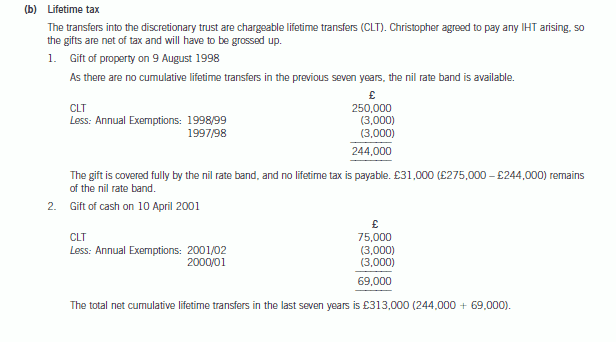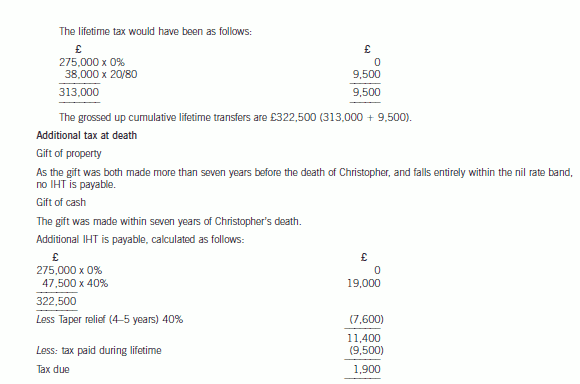不知道如何追加ACCA免试资格?看这里!
发布时间:2021-04-17
由于会计行业的高速发展,ACCA考试也越来越受到关注,那么,大家知道ACCA学员如何追加免试资格吗?今天51题库考试学习网为大家带来了相关内容,让我们一起来看看吧!
已注册成功的学员,在获得相关可申请免试的证书(例如会计学位、CPA证书)后可向ACCA申请追加免试,具体的步骤为:
1、将证书的原件和翻译件以电子版形式发送至 students@accaglobal.com
2、请注意查收邮件或登录MYACCA学员账户查看免试信息。
3、免试申请成功后,结果会显示接下来的一个考季,例如学员在4月份免试申请成功获得前三科,那么该免试结果显示的时间是6月份。
关于ACCA免考政策相关注意事项,详情如下:
1、申请牛津布鲁克斯大学的学士学位,不再需要英文证明
2、学员只有顺利通过整学年的课程才能够申请免试。
3、针对在校生的部分课程免试政策只适用于大学本科的在读学生,而不适用于硕士学位或大专学历的在读学生。
4、获得硕士学位和大专文凭的学生的免试课程只能按所学课程的相关性由ACCA免试评估部门进行逐门评估而定。
5、在中国,会计学学士学位是指会计学士、会计学学士、会计与金融学士或经济学学士(专业方向为会计学,会计与金融,国际会计,注册会计师)。
6、取得与会计学相关领域专业的学位都按“其他专业”对待,例如财务会计、工业会计、外贸会计、会计电算化、铁路会计等。
7、在大学第一学年所学过的课程不能作为申请免试的依据。
8、特许学位(即海外大学与中国本地大学合作而授予海外大学学位的项目),部分完成时不能申请免试。
9、本政策适用于在中国教育部认可的高等院校全部完成或部分完成本科课程的学生,而不考虑目前居住地点。
ACCA有效期:
ACCA学员有七年的时间通过专业阶段的考试。如果学员不能在七年内通过所有专业阶段考试,那么超过七年的已通过专业阶段科目的成绩将作废,须重新考试。七年时限从学员通过第一门专业阶段考试之日算起。
以上就是今天分享的全部内容了,希望能够帮到大家!51题库考试学习网在此预祝各位取得满意的成绩,如需了解更多相关内容,请持续关注51题库考试学习网!
下面小编为大家准备了 ACCA考试 的相关考题,供大家学习参考。
(b) Calculate the inheritance tax (IHT) liability arising as a result of Christopher’s death. (11 marks)



(b) You are the audit manager of Petrie Co, a private company, that retails kitchen utensils. The draft financial
statements for the year ended 31 March 2007 show revenue $42·2 million (2006 – $41·8 million), profit before
taxation of $1·8 million (2006 – $2·2 million) and total assets of $30·7 million (2006 – $23·4 million).
You are currently reviewing two matters that have been left for your attention on Petrie’s audit working paper file
for the year ended 31 March 2007:
(i) Petrie’s management board decided to revalue properties for the year ended 31 March 2007 that had
previously all been measured at depreciated cost. At the balance sheet date three properties had been
revalued by a total of $1·7 million. Another nine properties have since been revalued by $5·4 million. The
remaining three properties are expected to be revalued later in 2007. (5 marks)
Required:
Identify and comment on the implications of these two matters for your auditor’s report on the financial
statements of Petrie Co for the year ended 31 March 2007.
NOTE: The mark allocation is shown against each of the matters above.
(b) Implications for auditor’s report
(i) Selective revaluation of premises
The revaluations are clearly material to the balance sheet as $1·7 million and $5·4 million represent 5·5% and 17·6%
of total assets, respectively (and 23·1% in total). As the effects of the revaluation on line items in the financial statements
are clearly identified (e.g. revalued amount, depreciation, surplus in statement of changes in equity) the matter is not
pervasive.
The valuations of the nine properties after the year end provide additional evidence of conditions existing at the year end
and are therefore adjusting events per IAS 10 Events After the Balance Sheet Date.
Tutorial note: It is ‘now’ still less than three months after the year end so these valuations can reasonably be expected
to reflect year end values.
However, IAS 16 Property, Plant and Equipment does not permit the selective revaluation of assets thus the whole class
of premises would need to have been revalued for the year to 31 March 2007 to change the measurement basis for this
reporting period.
The revaluation exercise is incomplete. Unless the remaining three properties are revalued before the auditor’s report on
the financial statements for the year ended 31 March 2007 is signed off:
(1) the $7·1 revaluation made so far must be reversed to show all premises at depreciated cost as in previous years;
OR
(2) the auditor’s report would be qualified ‘except for’ disagreement regarding non-compliance with IAS 16.
When it is appropriate to adopt the revaluation model (e.g. next year) the change in accounting policy (from a cost model
to a revaluation model) should be accounted for in accordance with IAS 16 (i.e. as a revaluation).
Tutorial note: IAS 8 Accounting Policies, Changes in Accounting Estimates and Errors does not apply to the initial
application of a policy to revalue assets in accordance with IAS 16.
Assuming the revaluation is written back, before giving an unmodified opinion, the auditor should consider why the three
properties were not revalued. In particular if there are any indicators of impairment (e.g. physical dilapidation) there
should be sufficient evidence on the working paper file to show that the carrying amount of these properties is not
materially greater than their recoverable amount (i.e. the higher of value in use and fair value less costs to sell).
If there is insufficient evidence to confirm that the three properties are not impaired (e.g. if the auditor was prevented
from inspecting the properties) the auditor’s report would be qualified ‘except for’ on grounds of limitation on scope.
If there is evidence of material impairment but management fail to write down the carrying amount to recoverable
amount the auditor’s report would be qualified ‘except for’ disagreement regarding non-compliance with IAS 36
Impairment of Assets.
(c) Describe the main stages of a formal grievance procedure that Oliver should now pursue. (10 marks)
Part (c):
Grievance procedures must be accessible to all employees of Hoopers and Henderson at any level of the organisation and
regardless of their status. Managers must have suitable training in procedures and be provided with background as to how
grievances can occur in the first place. Grievance procedures must be regarded as beneficial and not threatening.
If an employee has a grievance, he or she should be able to pursue it and have the problem which has led to the grievance resolved.
A formal grievance procedure must be available, set out in writing and accessible to all employees. The procedure should consist
of five formal stages.
The first stage states the grade of employee or employees and their rights for each type of grievance.
The second stage details the actual procedures for pursuing a grievance, and is in four parts:
– The employee must discuss the grievance with his or her immediate supervisor or line manager.
– If the grievance can not be resolved at the first level, then the employee’s manager must become involved.
– The interview between the employee and manager takes place with the employee being allowed a representative if desired.
– If the grievance remains unresolved then the matter must be referred to a higher manager.
The third stage (referral to a higher manager) requires that the Human Resources Department or, in the case of Hoopers and
Henderson the partner responsible, must be informed.
The fourth stage is that written records must be kept and be available to all employees.
Finally, the procedure must be time limited.
Allowance must be made for the involvement of a trade union, staff association or individual support (if desired) at an appropriate
stage in the procedure.
At Hoopers and Henderson, Oliver has attempted to discuss the issue with his immediate manager (David Morgan) but without
success. He has therefore followed the procedure, but to continue correctly, Oliver must have taken up his grievance with the
manager next in seniority to David Morgan, who in this case is the partner responsible for human resources.
(ii) Calculate the corporation tax (CT) payable by Tay Limited for the year ended 31 March 2006, taking
advantage of all available reliefs. (3 marks)

声明:本文内容由互联网用户自发贡献自行上传,本网站不拥有所有权,未作人工编辑处理,也不承担相关法律责任。如果您发现有涉嫌版权的内容,欢迎发送邮件至:contact@51tk.com 进行举报,并提供相关证据,工作人员会在5个工作日内联系你,一经查实,本站将立刻删除涉嫌侵权内容。
- 2021-04-25
- 2020-01-10
- 2020-01-10
- 2021-02-26
- 2020-01-09
- 2021-04-25
- 2021-02-03
- 2020-01-09
- 2021-04-02
- 2020-03-21
- 2020-01-10
- 2020-01-09
- 2021-04-17
- 2020-01-08
- 2019-12-28
- 2020-02-20
- 2021-04-10
- 2020-01-09
- 2020-07-04
- 2020-09-03
- 2021-04-17
- 2020-02-22
- 2020-09-03
- 2020-01-10
- 2020-09-03
- 2021-01-02
- 2020-03-06
- 2020-01-08
- 2020-01-09
- 2020-01-09